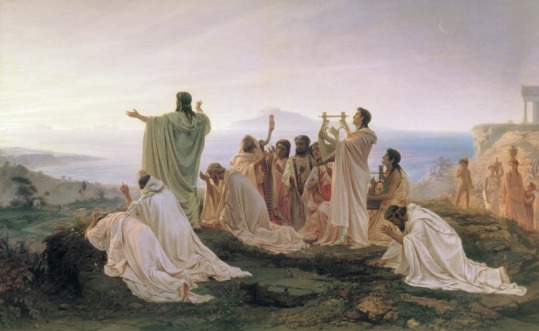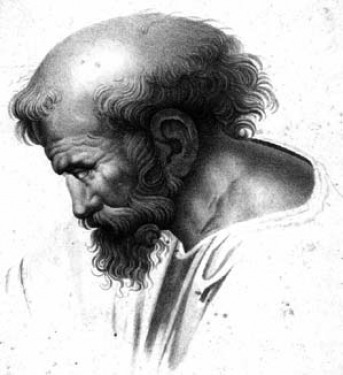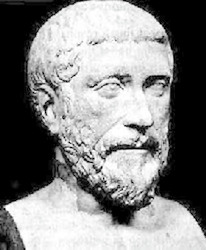14. History of Pythagoras and Pythagorean Theorem
15. Pythagoras, his theorem and his cult

Pythagoras (569-500 B.C.E.) was born on the island of Samos in Greece, and did much traveling through Egypt, learning, among other things, mathematics. Not much more is known of his early years. Pythagoras gained his famous status by founding a group, the Brotherhood of Pythagoreans, which was devoted to the study of mathematics. The group was almost cult-like in that it had symbols, rituals and prayers. In addition, Pythagoras believed that "Number rules the universe,"and the Pythagoreans gave numerical values to many objects and ideas. These numerical values, in turn, were endowed with mystical and spiritual qualities.
Since the fourth century AD, Pythagoras has commonly been given credit for discovering the Pythagorean theorem, a theorem in geometry that states that in a right-angled triangle the square of the hypotenuse (the side opposite the right angle), c, is equal to the sum of the squares of the other two sides, b and a—that is, a^2 + b^2 = c^2.
While the theorem that now bears his name was known and previously utilized by the Babylonians and Indians, he, or his students, are often said to have constructed the first proof. It must, however, be stressed that the way in which the Babylonians handled Pythagorean numbers, implies that they knew that the principle was generally applicable, and knew some kind of proof, which has not yet been found in the (still largely unpublished) cuneiform sources. Because of the secretive nature of his school and the custom of its students to attribute everything to their teacher, there is no evidence that Pythagoras himself worked on or proved this theorem. For that matter, there is no evidence that he worked on any mathematical or meta-mathematical problems. Some attribute it as a carefully constructed myth by followers of Plato over two centuries after the death of Pythagoras, mainly to bolster the case for Platonic meta-physics, which resonate well with the ideas they attributed to Pythagoras. This attribution has stuck, down the centuries up to modern times. The earliest known mention of Pythagoras's name in connection with the theorem occurred five centuries after his death, in the writings of Cicero and Plutarch.Megalithic monuments from circa 2500 BC in Egypt, and in Northern Europe, incorporate right triangles with integer sides. Bartel Leendert van der Waerden conjectures that these Pythagorean triples were discovered algebraically.
Written between 2000 and 1786 BC, the Middle Kingdom Egyptian papyrus Berlin 6619 includes a problem whose solution is a Pythagorean triple.
The Mesopotamian tablet Plimpton 322, written between 1790 and 1750 BC during the reign of Hammurabi the Great, contains many entries closely related to Pythagorean triples.The Baudhayana Sulba Sutra, the dates of which are given variously as between the 8th century BC and the 2nd century BC, in India, contains a list of Pythagorean triples discovered algebraically, a statement of the Pythagorean theorem, and a geometrical proof of the Pythagorean theorem for an isosceles right triangle.
The Apastamba Sulba Sutra (circa 600 BC) contains a numerical proof of the general Pythagorean theorem, using an area computation. Van der Waerden believes that "it was certainly based on earlier traditions". According to Albert Bŭrk, this is the original proof of the theorem; he further theorizes that Pythagoras visited Arakkonam, India, and copied it.
Written sometime between 500 BC and 200 AD, the Chinese text Chou Pei Suan Ching, (The Arithmetical Classic of the Gnomon and the Circular Paths of Heaven) gives a visual proof of the Pythagorean theorem — in China it is called the "Gougu Theorem" — for the (3, 4, 5) triangle. During the Han Dynasty, from 202 BC to 220 AD, Pythagorean triples appear in The Nine Chapters on the Mathematical Art, together with a mention of right triangles. The first recorded use is in China (where it is alternately known as the "Shang Gao Theorem", named after the Duke of Zhou's astrologer, and described in the mathematical collection Zhou Bi Suan Jing) and in India, where it is known as the Bhaskara Theorem.
Legend has it that upon completion of his famous theorem, Pythagoras sacrificed 100 oxen. Although he is credited with the discovery of the famous theorem, it is not possible to tell if Pythagoras is the actual author. The Pythagoreans wrote many geometric proofs, but it is difficult to ascertain who proved what, as the group wanted to keep their findings secret.
Unfortunately, this vow of secrecy prevented an important mathematical idea from being made public. The Pythagoreans had discovered irrational numbers! If we take an isosceles right triangle with legs of measure 1, the hypotenuse will measure sqrt 2. But this number cannot be expressed as a length that can be measured with a ruler divided into fractional parts, and that deeply disturbed the Pythagoreans, who believed that "All is number." They called these numbers "alogon," which means "unutterable." So shocked were the Pythagoreans by these numbers that according to legend, Hippasus, who first proved the irrationality of the square root of two, was drowned at sea as a consequence. It would be 200 years later that the Greek mathematician Eudoxus developed a way to deal with these unutterable numbers.
Accurate facts about the life of Pythagoras are so few, and most information concerning him is of so late a date, and so untrustworthy, that it is impossible to provide more than a vague outline of his life. The lack of information by contemporary writers, together with the secrecy which surrounded the Pythagorean brotherhood, meant that invention took the place of facts. The stories which were created were eagerly sought by the Neoplatonist writers who provide most of the details about Pythagoras, but who were uncritical concerning anything which related to the gods or which was considered divine. Thus many myths were created – such as that Apollo was his father; that Pythagoras gleamed with a supernatural brightness; that he had a golden thigh; that Abaris came flying to him on a golden arrow; that he was seen in different places at one and the same time.
With the exception of a few remarks by Xenophanes, Heraclitus, Herodotus, Plato, Aristotle, and Isocrates, we are mainly dependent on Diogenes Laërtius, Porphyry, and Iamblichus for the biographical details. Aristotle had written a separate work on the Pythagoreans, which unfortunately has not survived. His disciples Dicaearchus, Aristoxenus, and Heraclides Ponticus had written on the same subject. These writers, late as they are, were among the best sources from whom Porphyry and Iamblichus drew, besides the legendary accounts and their own inventions. Hence historians are often reduced to considering the statements based on their inherent probability, but even then, if all the credible stories concerning Pythagoras were supposed true, his range of activity would be impossibly vast.
(http://www.geom.uiuc.edu/~demo5337/Group3/hist.html) (http://en.wikipedia.org/wiki/Hippasus) (http://en.wikipedia.org/wiki/Pythagoras) (http://en.wikipedia.org/wiki/Pythagorean_theorem)
Since the fourth century AD, Pythagoras has commonly been given credit for discovering the Pythagorean theorem, a theorem in geometry that states that in a right-angled triangle the square of the hypotenuse (the side opposite the right angle), c, is equal to the sum of the squares of the other two sides, b and a—that is, a^2 + b^2 = c^2.
While the theorem that now bears his name was known and previously utilized by the Babylonians and Indians, he, or his students, are often said to have constructed the first proof. It must, however, be stressed that the way in which the Babylonians handled Pythagorean numbers, implies that they knew that the principle was generally applicable, and knew some kind of proof, which has not yet been found in the (still largely unpublished) cuneiform sources. Because of the secretive nature of his school and the custom of its students to attribute everything to their teacher, there is no evidence that Pythagoras himself worked on or proved this theorem. For that matter, there is no evidence that he worked on any mathematical or meta-mathematical problems. Some attribute it as a carefully constructed myth by followers of Plato over two centuries after the death of Pythagoras, mainly to bolster the case for Platonic meta-physics, which resonate well with the ideas they attributed to Pythagoras. This attribution has stuck, down the centuries up to modern times. The earliest known mention of Pythagoras's name in connection with the theorem occurred five centuries after his death, in the writings of Cicero and Plutarch.Megalithic monuments from circa 2500 BC in Egypt, and in Northern Europe, incorporate right triangles with integer sides. Bartel Leendert van der Waerden conjectures that these Pythagorean triples were discovered algebraically.
Written between 2000 and 1786 BC, the Middle Kingdom Egyptian papyrus Berlin 6619 includes a problem whose solution is a Pythagorean triple.
The Mesopotamian tablet Plimpton 322, written between 1790 and 1750 BC during the reign of Hammurabi the Great, contains many entries closely related to Pythagorean triples.The Baudhayana Sulba Sutra, the dates of which are given variously as between the 8th century BC and the 2nd century BC, in India, contains a list of Pythagorean triples discovered algebraically, a statement of the Pythagorean theorem, and a geometrical proof of the Pythagorean theorem for an isosceles right triangle.
The Apastamba Sulba Sutra (circa 600 BC) contains a numerical proof of the general Pythagorean theorem, using an area computation. Van der Waerden believes that "it was certainly based on earlier traditions". According to Albert Bŭrk, this is the original proof of the theorem; he further theorizes that Pythagoras visited Arakkonam, India, and copied it.
Written sometime between 500 BC and 200 AD, the Chinese text Chou Pei Suan Ching, (The Arithmetical Classic of the Gnomon and the Circular Paths of Heaven) gives a visual proof of the Pythagorean theorem — in China it is called the "Gougu Theorem" — for the (3, 4, 5) triangle. During the Han Dynasty, from 202 BC to 220 AD, Pythagorean triples appear in The Nine Chapters on the Mathematical Art, together with a mention of right triangles. The first recorded use is in China (where it is alternately known as the "Shang Gao Theorem", named after the Duke of Zhou's astrologer, and described in the mathematical collection Zhou Bi Suan Jing) and in India, where it is known as the Bhaskara Theorem.
Legend has it that upon completion of his famous theorem, Pythagoras sacrificed 100 oxen. Although he is credited with the discovery of the famous theorem, it is not possible to tell if Pythagoras is the actual author. The Pythagoreans wrote many geometric proofs, but it is difficult to ascertain who proved what, as the group wanted to keep their findings secret.
Unfortunately, this vow of secrecy prevented an important mathematical idea from being made public. The Pythagoreans had discovered irrational numbers! If we take an isosceles right triangle with legs of measure 1, the hypotenuse will measure sqrt 2. But this number cannot be expressed as a length that can be measured with a ruler divided into fractional parts, and that deeply disturbed the Pythagoreans, who believed that "All is number." They called these numbers "alogon," which means "unutterable." So shocked were the Pythagoreans by these numbers that according to legend, Hippasus, who first proved the irrationality of the square root of two, was drowned at sea as a consequence. It would be 200 years later that the Greek mathematician Eudoxus developed a way to deal with these unutterable numbers.
Accurate facts about the life of Pythagoras are so few, and most information concerning him is of so late a date, and so untrustworthy, that it is impossible to provide more than a vague outline of his life. The lack of information by contemporary writers, together with the secrecy which surrounded the Pythagorean brotherhood, meant that invention took the place of facts. The stories which were created were eagerly sought by the Neoplatonist writers who provide most of the details about Pythagoras, but who were uncritical concerning anything which related to the gods or which was considered divine. Thus many myths were created – such as that Apollo was his father; that Pythagoras gleamed with a supernatural brightness; that he had a golden thigh; that Abaris came flying to him on a golden arrow; that he was seen in different places at one and the same time.
With the exception of a few remarks by Xenophanes, Heraclitus, Herodotus, Plato, Aristotle, and Isocrates, we are mainly dependent on Diogenes Laërtius, Porphyry, and Iamblichus for the biographical details. Aristotle had written a separate work on the Pythagoreans, which unfortunately has not survived. His disciples Dicaearchus, Aristoxenus, and Heraclides Ponticus had written on the same subject. These writers, late as they are, were among the best sources from whom Porphyry and Iamblichus drew, besides the legendary accounts and their own inventions. Hence historians are often reduced to considering the statements based on their inherent probability, but even then, if all the credible stories concerning Pythagoras were supposed true, his range of activity would be impossibly vast.
(http://www.geom.uiuc.edu/~demo5337/Group3/hist.html) (http://en.wikipedia.org/wiki/Hippasus) (http://en.wikipedia.org/wiki/Pythagoras) (http://en.wikipedia.org/wiki/Pythagorean_theorem)
16. Words of Pythagoras

Number rules the universe.
Quoted in D MacHale, Comic Sections (Dublin 1993)
Number is the ruler of forms and ideas, and the cause of gods and demons.
Iamblichus
Every man has been made by God in order to acquire knowledge and contemplate.
Geometry is knowledge of the eternally existent.
Number is the within of all things.
There is geometry in the humming of the strings.
Time is the soul of this world.
Quoted in Des MacHale, Wisdom (London, 2002).
(http://www-groups.dcs.st-and.ac.uk/~history/Quotations/Pythagoras.html)
Quoted in D MacHale, Comic Sections (Dublin 1993)
Number is the ruler of forms and ideas, and the cause of gods and demons.
Iamblichus
Every man has been made by God in order to acquire knowledge and contemplate.
Geometry is knowledge of the eternally existent.
Number is the within of all things.
There is geometry in the humming of the strings.
Time is the soul of this world.
Quoted in Des MacHale, Wisdom (London, 2002).
(http://www-groups.dcs.st-and.ac.uk/~history/Quotations/Pythagoras.html)





